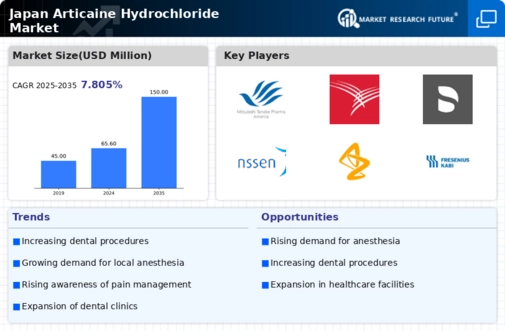The articaine hydrochloride market in Japan is characterized by a competitive landscape that is increasingly shaped by innovation, strategic partnerships, and regional expansion. Key players such as Septodont (FR), Dentsply Sirona (US), and B. Braun Melsungen AG (DE) are actively pursuing strategies that enhance their market positioning. Septodont, for instance, focuses on product innovation and has been enhancing its portfolio to include advanced formulations of articaine, which may cater to the evolving needs of dental practitioners. Dentsply Sirona, on the other hand, appears to be leveraging its extensive distribution network to penetrate deeper into the Japanese market, while B. Braun Melsungen AG emphasizes sustainability in its operations, potentially appealing to environmentally conscious consumers. Collectively, these strategies contribute to a dynamic competitive environment where differentiation is increasingly based on innovation and operational efficiency.
In terms of business tactics, companies are localizing manufacturing to reduce costs and optimize supply chains, which is particularly relevant in the context of Japan's unique regulatory landscape. The market structure is moderately fragmented, with several players vying for market share, yet the influence of major companies remains substantial. This competitive structure suggests that while there is room for smaller entities, the established players are likely to dominate through their extensive resources and strategic initiatives.
In October 2025, Septodont (FR) announced the launch of a new articaine formulation designed specifically for pediatric dentistry. This strategic move is significant as it not only expands their product line but also addresses a niche market that has been underrepresented in the past. By focusing on pediatric applications, Septodont may enhance its brand loyalty among dental professionals who prioritize specialized care for younger patients.
In September 2025, Dentsply Sirona (US) entered into a partnership with a leading Japanese dental school to develop training programs that incorporate their latest articaine products. This collaboration is likely to strengthen Dentsply's presence in the educational sector, fostering brand recognition among future dental practitioners. Such initiatives may also facilitate feedback loops that inform product development, ensuring that offerings remain aligned with practitioner needs.
In August 2025, B. Braun Melsungen AG (DE) unveiled a sustainability initiative aimed at reducing the carbon footprint of its manufacturing processes. This initiative is particularly relevant in the current market climate, where consumers and healthcare providers are increasingly prioritizing environmentally friendly products. By positioning itself as a leader in sustainability, B. Braun may not only enhance its competitive edge but also attract a growing segment of eco-conscious customers.
As of November 2025, the competitive trends in the articaine hydrochloride market are increasingly defined by digitalization, sustainability, and the integration of artificial intelligence in product development and customer engagement. Strategic alliances are becoming more prevalent, as companies recognize the value of collaboration in enhancing innovation and market reach. Looking ahead, it is anticipated that competitive differentiation will evolve from traditional price-based strategies to a focus on technological advancements, innovative product offerings, and reliable supply chains. This shift underscores the importance of adaptability and forward-thinking in maintaining a competitive advantage in a rapidly changing market.



















Leave a Comment